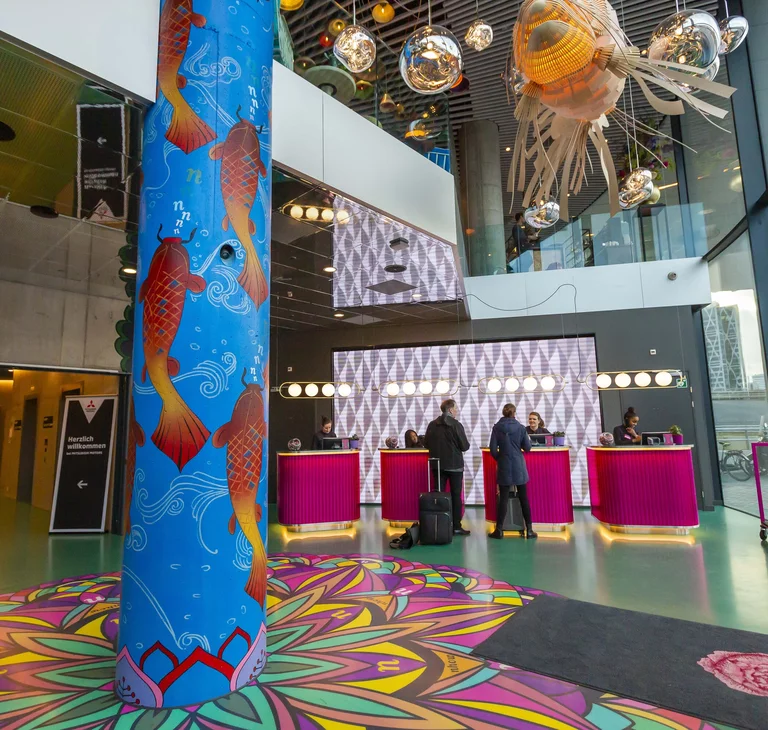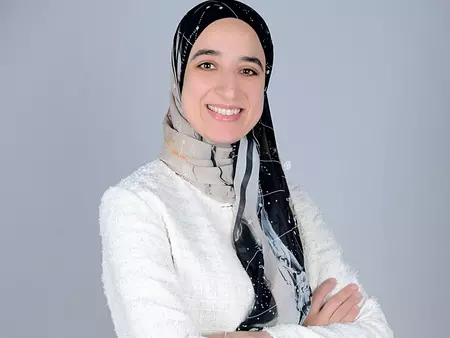Downloadliste

Fresh Air for Hotels
WOLF, based in Mainburg, provides its professional clients with competent contacts who support them throughout the entire project phase. Alshaimaa Abdelaziz, WOLF Business Development Air Handling, explains the specific challenges in the hotel sector and the solutions.
You are the contact person for many hotel clients. What sets you apart?
Alshaimaa Abdelaziz: In Business Development Air Handling at WOLF, I am the international contact for partners and clients working in the hotel sector. My role is to build a bridge between high-performance climate technology and the specific requirements of hotels.
At WOLF, we have a deep understanding of both the diverse aspects of hotel operations and technical climate solutions. We are involved early in the project phase, listen to the client’s ideas, identify technical challenges, and offer tailored proposals for energy-efficient and comfortable air conditioning

From precise humidity and CO₂ control to optimal air circulation and energy recovery, we help our clients create the ideal feel-good climate for their guests and staff – always invisible and whisper-quiet.
In close collaboration with planners, system designers, and integrators, we ensure that WOLF systems meet both the comfort requirements and the economic goals of investors. This includes support with feasibility studies, concept development, and the integration of automation and sustainability strategies.
In a hotel, there are different requirements for climate technology – for example, a spa area has different needs than a restaurant with a kitchen or a hotel room. What challenges do you face?
Alshaimaa Abdelaziz:Indeed, the individual functional areas not only have fundamentally different requirements, but they are also subject to different standards and regulations. For lobbies, pools, underground garages, guest rooms with bathrooms, restaurants and bars with kitchens, conference and event rooms, as well as sports and spa areas, there are recurring themes that we examine with our clients at the beginning of the project:
The most important aspect is the optimal climate of the respective rooms, i.e., which specifications must be met according to the relevant standards and guidelines. Technically, this simply means heating, cooling, dehumidifying, and humidifying.
The second major topic is the efficient use of energy, as energy efficiency is a key issue when it comes to the economic viability of the system technology. This involves not only efficient components but also intelligent and demand-driven control.
Especially in the kitchen and restaurant areas, hygiene plays an important role, closely followed by occupational safety and fire protection.
A relatively new demand from investors is achieving a low CO₂ footprint, which goes hand in hand with low operating costs thanks to the high efficiency of air handling technology.
Guest expectations are rising, as is their mobility: What opportunities are there for the future in the hotel industry?
Alshaimaa Abdelaziz: Hotels are like real estate in general. Above all, location matters. Exclusive central locations are still in high demand compared to peripheral ones and are almost synonymous with exquisite furnishings. And this is precisely where ventilation technology plays a crucial role.
For the guest, it doesn’t matter whether the hotel is next to an airport, in the desert, or in a tropical climate zone. As soon as they enter the building, they must be greeted by a pleasant, air-conditioned atmosphere that stands out positively from the potentially inhospitable outside world. In view of climate change and increasing mobility, we see efficient to green ventilation technology as a key technology.
Why is central ventilation technology more sensible than decentralized solutions?
Alshaimaa Abdelaziz: There are many arguments against decentralized air conditioning systems: From a technical perspective, they “score” with low energy efficiency due to the lack of heat recovery and inexpensive but inefficient components that generally do not last long. Since each unit must be regulated and maintained separately, central control or monitoring is not possible, and air quality cannot be monitored or integrated into a central building management system. This ultimately means a high CO₂ footprint for the building and high energy costs.
In the rooms themselves, ceiling and wall units disrupt the interior design. They produce audible operating noise, often accompanied by drafts. If the devices are inadequately maintained for economic reasons, germs and mold can form in their hard-to-reach areas. At that point, hygiene and air quality can no longer be guaranteed. The simple filters typically used are no longer sufficient.
In contrast, centralized and highly durable ventilation units, as part of the building management system, can be regulated very well according to demand and are highly energy-efficient thanks to at least 80 percent heat recovery, making them suitable for use in DGNB or LEED-certified green buildings. Since the hygienically filtered air can be humidified or dehumidified as needed, centralized ventilation units ensure consistently good air quality 365 days a year. The fresh, air-conditioned supply air is introduced into the individual rooms whisper-quietly and draft-free via sound-decoupled components, controlled by CO₂ and humidity sensors, and is likewise extracted. This means maximum comfort for hotel guests and, for example, pleasant working conditions in the hotel kitchen.
Is there a specific WOLF approach to finding solutions for hotels?
Alshaimaa Abdelaziz: Our greatest strength lies in the personal and collaborative relationships with our customers and their planners, often established over decades. At the same time, WOLF has been offering air handling solutions “Made in Germany” for over 60 years. For more than 50 years, we have been active in hotels around the world – so we know the requirements very well. Of course, we have not stood still in the development of our solutions. Thanks to intelligent control systems, we monitor and manage every room with state-of-the-art technology and the highest hygiene standards. Our service and spare parts support are also available around the clock.
What solutions for hotels do you offer?
Alshaimaa Abdelaziz: The diversity of requirements from areas such as guest rooms, conference rooms, wellness, kitchen and restaurant, as well as corridors and ancillary rooms, does not allow for a completely uniform and efficient ventilation solution. Therefore, we offer individual and standards-compliant solutions for wellness and spa areas, kitchens, and restaurants. The ventilation technology in these areas must meet special requirements, especially when ventilation for other hotel spaces is considered a basic technical provision. These specific requirements range from hygiene regulations to occupational and fire protection, and tailored dehumidification.
In summary: Energy-efficient WOLF air handling technology with heat recovery and whisper-quiet state-of-the-art fan technology significantly reduces the heating and cooling demand of a hotel – and thus also the energy costs and CO₂ footprint of the building. Our highly energy-efficient air handling units are therefore also used in DGNB or LEED-certified green buildings
Is the CO₂ footprint of your customers also a focus when planning ventilation systems?
Alshaimaa Abdelaziz: We always respond individually to customer requirements. The three pillars of energy efficiency in ventilation technology are heat recovery, the use of highly efficient components that consume drive energy, and intelligent, demand-oriented control of the ventilation system. In close consultation with our customers, we reduce the CO₂ footprint to the extent desired, using many small and large levers: These range from state-of-the-art EC fan technology to heat exchangers and special sealing systems, all the way to innovative hydraulic schemes.
.
Are there also industry-specific special requests for which WOLF offers a solution?
Alshaimaa Abdelaziz: In the past, WOLF only offered white ventilation units. This often does not match the architecture when units are installed outdoors. While we cannot change the shape of our units – “form follows function” – we can certainly change the colour: There is probably no RAL colour shade that we haven’t delivered yet.
Further information on WOLF air handling units can be found at: https://www.wolf.eu/en-de/professional/ahu-products